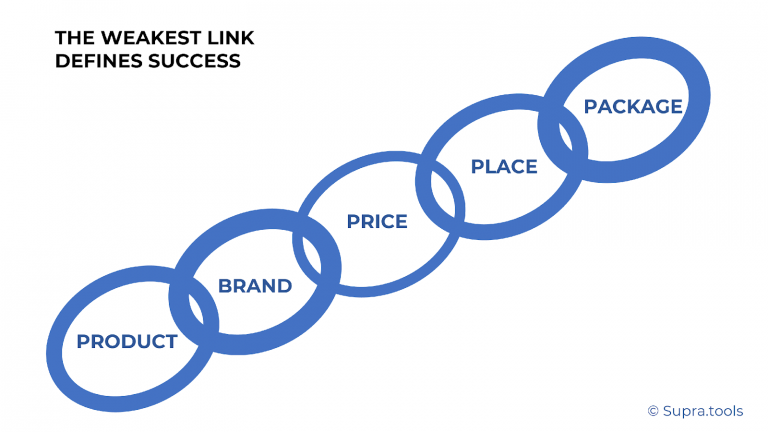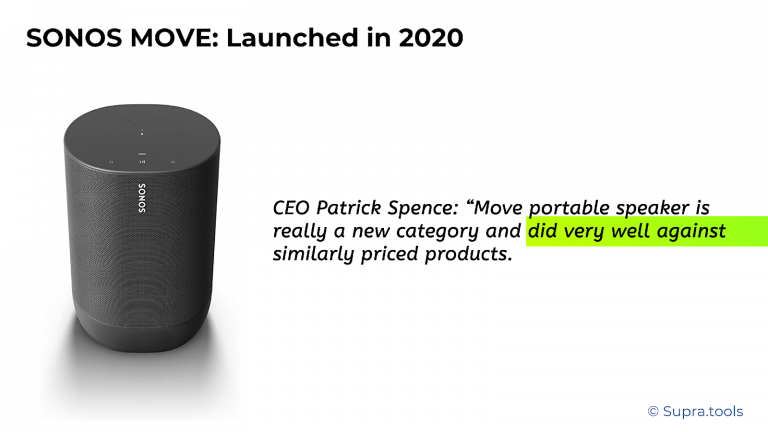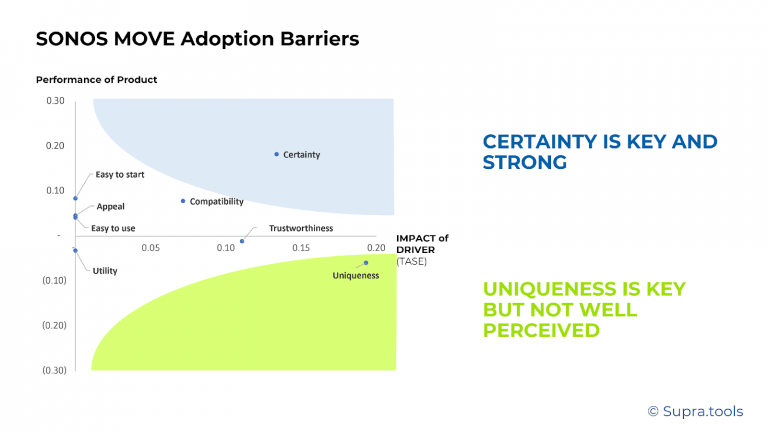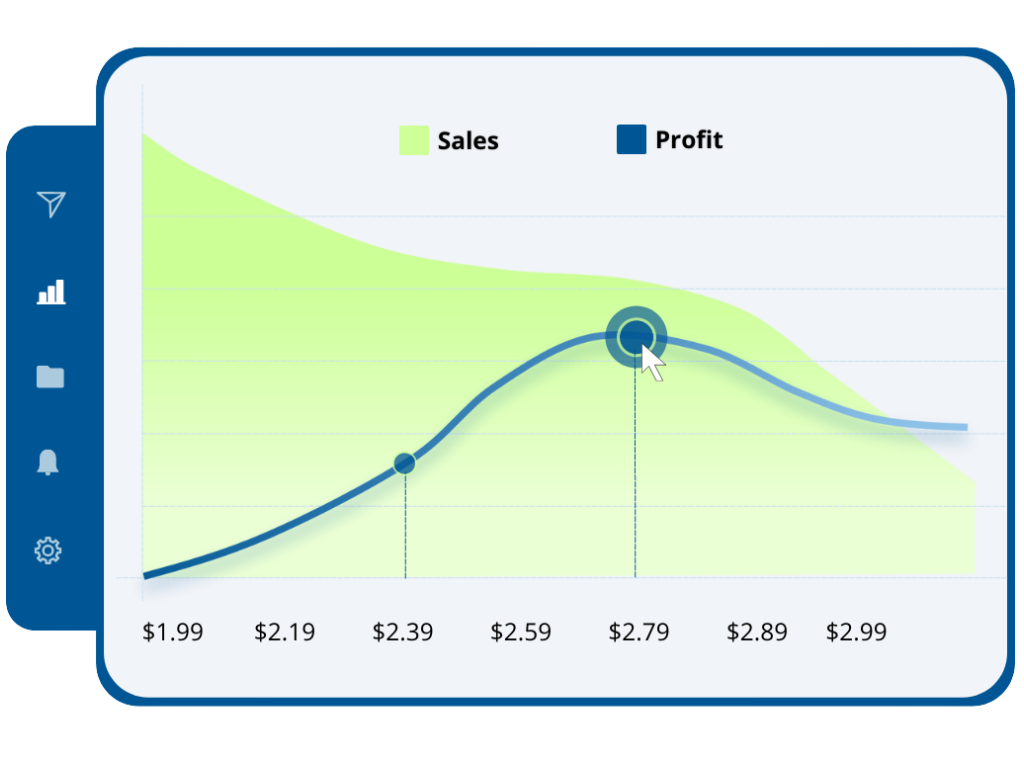July 6, 2022
How do I check the market product fit?


Unlike in other industries, it is “common knowledge” in the consumer goods sector that some form of market research is needed to find out how promising a product innovation is. Nevertheless, 95% of all market launches fail.
The reasons for this are complex because you have to do a lot of things right to launch a product with a “product-market fit”. These 5 levers are crucial:
All these levers are well known to consumer goods manufacturers. However, when it comes to management, most brands are based on an incorrect basic assumption. This assumes that mediocre management of one factor can be compensated for by stellar performance of another.

The internal euphoria surrounding great product innovations often obscures the fact that a great product won’t sell if it’s not in the store, isn’t perceived as a brand, is too expensive or too cheap.

We call this phenomenon the “MULTIPLY” effect. 95% of all launches fail because they underperform in one of the 5 factors. It is like a chain. The weakest link defines the overall performance.
Product-market fit is usually evaluated through product testing and concept testing. This includes levers 1 and 2, but leaves out the other levers.
These tests highlight specific facets of consumer perception. “Is the benefit clear?”, “Do I believe the promise?”, “Is it easy to apply?”, “Does it fit with lifestyle habits?”, and many more. But what is often not considered is what role these facets really play in the purchase decision.
The question is what simple steps even mid-sized brands can take that will significantly improve the chance of successful launches.
The bestselling book „Pricing Intelligence“ has more on the topic and
A new approach is able to take into account the MULTIPLY effect and test their innovation holistically. This can
– Significantly increase the validity of concept and packaging testing
– Ensure price acceptance
– Identify causes of adoption barriers
– And broaden distribution through initial success

In 2020, SONOS successfully launched its mobile speakers MOVE and ROAM, which, unlike competing products, could be controlled via WLAN and thus offered various advantages.
Already two years before, the brand conducted product tests, which were integrated with a price test through a special method. This was made possible by using Implicit IntelligenceTM.
In addition, the product concepts were evaluated by the test subjects in terms of the extent to which they met typical adoption criteria. A subsequent driver analysis (Causal AI) revealed a communication gap:
For the adoption of new products, it is important that potential customers recognize the newness or uniqueness of the product. This was precisely the point where there was a need to catch up. It was not clear to consumers what the difference was between this and a normal mobile Bluetooth speaker.

The marketing department, therefore, placed particular emphasis in the marketing communication on highlighting the special advantages of the Wifi functionality.
The success of the launch speaks for itself. The communication answered the key questions and the price was optimized to maximize profits.

Integrate PRICE: A product test IS a price test
A product’s market fit can only be determined very inaccurately if price is left out of the equation. Most people would prefer a premium car to an entry-level model. But the decisive factor is whether the added value for me individually justifies the price.
So why not test the product in its entirety – including its price?
Today, this is not done in most cases due to methodological difficulties. However, as I will show in a moment, methods are available today that combine product testing with price testing in a quite automated way, thus killing two birds with one stone.
Some professionals prefer to access video tutorials around pricing and insights

IMPLICIT – Measure Product-Market Fit and Acceptance Implicitly
There are three reasons why product and price are tested separately today:
Interestingly, Implicit IntelligenceTM methods solve these challenges in an elegant way and much deeper than the Net Promoter Score (NPS). They represent a simple but very valid measurement method of price willingness. In it, neuroscientific measurement methods (Implicit) are combined with causal calibrations through Machine Learning (Intelligence).
The measurement approach is closely related to that of the product test, since in the same way the product is presented extensively in the first step.
By implicitly attesting the willingness to buy at different price points, the respondent measures real product acceptance and thus product-market fit.

BRAND – Brand control
Just as it makes sense to integrate price and product in one test, a product-market-fit test is especially valid if the “mental availability” (i.e. the anchoring of the brand in the consumer’s memory) existing at the time of the purchase situation is taken into account.
Two aspects must be distinguished here
If it is planned to invest heavily in product communication in the course of the market launch, an acceptance and price-sales function for the product at market launch and after market launch can be distinguished by underweighting or overweighting the brand loyalists. At launch, there is still less brand loyalty and therefore a lower probability of acceptance.

ADOPTION DRIVERS – Tracking down adoption causes
Up to this point, we have evaluated the product-market fit and thus at the same time found the optimal price and understood what role the brand and communication campaign will play.
In the often iterative process of product launch, brands usually want to know how to improve product market fit and thus product adoption. After all, changes in packaging and communication are always possible – in some cases, even to the product itself.
For this, the science of adoption research has proven the classic 8 drivers of product adoption. They are universal for all products. Only their importance for each product category and each market may be completely different.

The very individual significance can be determined by so-called driver analyses. In addition a test person must still evaluate in the follow-up to the product test, to what extent the product: is simple, pleases, is technically or psychologically compatible, the promised use will occur, the product has at all an increase in value, and some more.
A driver analysis now finds a mathematical formula with which it is possible to predict the propensity to buy with the help of the adoption profile. In doing so, it is possible to read from the formula which importance which adoption cause has.

Successful product launches are rare. 95% fail. A central cause is that the interaction of product, brand and price is underestimated. In addition, the methods used for pricing new products are usually not very valid.
With the help of the PIMA approach, it is possible to solve this problem better. For example, the platform Supra.tools offers an extension of its PriceOptimizer tool and thus identifies the relevant adoption gaps and the role of the brand.
The approach is based on 1. testing product and price in one, 2. doing this methodically implicitly, 3. controlling the role of the brand, and 4. identifying adoption drivers and gaps.
The success of pioneers like SONOS prove the approach right. It can be implemented easily and cost-effectively via platforms such as Supra.tools.

Today pioneers use the latest pricing survey tools that use Neuroscience + AI
Interested professionals can use some tools even for free and explore on its own
You can access supra tools free here.
What is Product-Market Fit?
Product Market Fit describes the match between a specific product and the needs and desires of the target group in a target market. This means that the product is relevant and useful to the target group. The match can be on both a functional and emotional level. The important thing is that the product meets the needs of the target group and they are willing to pay for it.
How did the term originate and where did it come from?
According to Wikipedia, Don Valentine invented the term
According to Andy Rachleff, co-founder of Benchmark Capital, Don Valentine, founder of Sequoia Capital, coined the term product-market fit.
Andreesen Horowitz popularized the concept
Andreesen Horowitz popularized the term in the startup world in the mid-2000s, defining it as follows: Product-market fit means being in a good market with a product that can satisfy that market.” Many have since interpreted product/market fit as creating what is known as a Minimum Viable Product that addresses and solves an existing problem or need.

Andrew Chen puts it to impressive use
Andrew Chen is an American entrepreneur, investor, blogger, and founder and partner at venture capital firm Andreesen Horowitz and is involved in startups. He is the founder of Uber, and was previously the director of product development at StumbleUpon. His investments include AppDirect, Airtable, C2FO, CloudOn, Humin (acquired by Tinder), Kabam, Lookout, Milo (acquired by eBay), Nest (acquired by Google), Pure Storage, Zenefits and Zoosk.
Dan Olsen writes the advancement “The Lean Product Playbook”.
Dan Olsen is also a pioneer and user of the Product Market Fit concept and coaches companies like Google, Walmart, Amazon, Facebook and Microsoft.
Alexander Osterwalder further develops the concept according to the Canvas paradigm
In terms of Alexander Osterwalder’s Business Model Canvas paradigm, product-market fit means a combination of value proposition, target market, target customer segment, relationship and channel. Achieving product-market fit requires that these elements are fixed, with no additional changes or pivots required.
How do you find the right market for your product?
That’s a good question. Most entrepreneurs make the mistake of thinking they can sell their product to anyone. But they can’t. Every market is different and you have to take the time to find the right market for your product. There are several ways to find the right market for your product. For example, you can do market research or talk to experts. But the best way is to try it out yourself and find out which market is best for your product. How do you make sure your product fits the market? There are several ways to make sure a product matches the market. First, companies should conduct solid market research to determine consumer needs and wants. Based on these findings, they can then decide which products to produce and offer. In addition, it is important to communicate regularly with customers to ensure that the product meets their expectations.
What is the best way to communicate the product?
In today’s world, it is important for companies to promote their products on various digital platforms. This is because more and more people are finding out about the products they want to buy online. In order to be successful on the digital platforms, it is important that companies develop a strategy to best communicate their product.
What are product market fit examples of successful products?
– Apple iPhone: The product exactly meets the customer’s need for an intuitive, powerful and stylish smartphone. The high market demand for the iPhone shows that there is a large market for this product. – Tesla Model S: The product precisely meets customers’ need for an environmentally friendly, powerful and luxurious electric car. The high market demand for the Model S shows that there is a large market for this product.
GoPro Hero4: The product meets exactly the need of customers for a compact, powerful and robust action camera. The high market demand for the Hero4 shows that there is a large market for this product.
What is meant by the 40% rule in the context of achieving product-market fit.
The 40% rule is a very important concept when it comes to product-market fit. This rule states that you cannot call a product successful until it is actually used by at least 40% of the targeted customers. This number may seem a little low at first glance, but it is very important. When you consider that most startups fail because they are unable to find a large enough number of customers willing to use their product, it’s clear why the 40% rule is so important. There is, of course, no guarantee that a product with a 40% usage rate will actually be successful. However, there are some very successful companies that have achieved this number and are very successful today. Therefore, it is definitely an indicator to keep an eye on.
According to a study by CB Insights, startups need an average of six months to reach the so-called “product-market fit”. This means that the product is attractive to 40% of customers and that they would buy it. In most cases, it is not possible to achieve product-market fit immediately. Rather, it is a process that evolves over several iterations of the product and marketing. Nevertheless, it is important to keep the goal in mind and do everything possible to reach the magic 40% mark. Because once that goal is reached, the company’s growth can accelerate greatly.
How do you achieve product-market fit and how can you measure it?
There are five metrics that any online business can measure product-market fit to empirically verify that it has achieved product-market fit:
If these 5 metrics are above average and your 40% rule is met, you know you have a product market fit company.
Product Market Fit vs. Problem/Solution Fit
When measuring target customers desire, companies need to be sure they are measuring desire for the product or service and not just for a solution. Misinterpreting target customers desire for a solution as a desire for a company’s product or service will result in a false positive for product/market fit.
Product-Market Fit is about whether the product is suitable for the market. Problem-Solution Fit looks at whether the product can solve the problem. Both factors are important to be successful.
In my email newsletter “Pricing Insights” I cover the whole range of pricing insights solutions-from Garbor Granger to Conjoint, from NeuroPricing to Pricing Software Systems. I describe the application in various fields from new product pricing to promotion, from brand premium to feature pricing.
Keep up to date here.